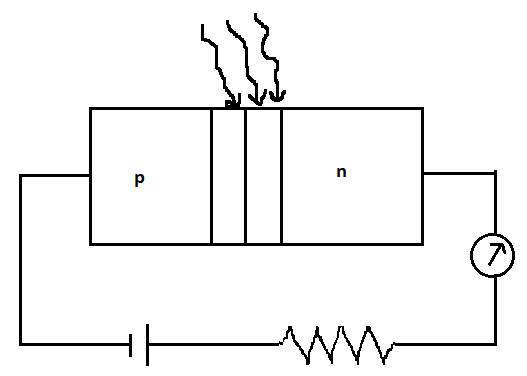
With what consideration in view, a photodiode is fabricated? State its working with the help of a suitable diagram. Even though the current in the forward bias is known to be more than in the reverse bias, yet the photodiode works in reverse bias. What is the reason?
Answer
488.4k+ views
Hint: Recall all the concepts related to photodiode, its working, its fabrication, with a proper diagram. Always remember reverse bias current is mainly due to the minority charge carriers and photo current increases significantly in reverse bias. Keep in mind the standard diode equation.
Complete step by step solution:
Photodiode is a semiconductor device with P-N junction that converts light into an electric signal or current. When the light or photons are absorbed by the photodiodes, the current is generated. A photodiode is fabricated with the consideration that the maximum amount of light reaches the intrinsic layer of a photodiode. Material such as GaAs or Si is used for the fabrication as their energy band gap is
Working:

The working principle of photodiode is, when the photons strike the diode, electron-hole pairs are generated. If the absorption arises in the depletion region junction, then the electron charge carriers are removed from the junction by the in-built electric field of the depletion region. The value of reverse saturation current depends on the intensity of incident radiation and is independent of reverse bias.
Reason:
When photodiode is operated in reverse condition, the change in reverse saturation current is directly proportional to the change in incident light intensity. A very small change in the minority charge carrier obtained under reverse bias, is much more than the corresponding fraction change in majority carrier current obtained under forward bias.
Note: It is easier to observe in the current, with change in light intensity, if a reverse bias is applied. The photodiode works in three modes, namely Photovoltaic mode, Photoconduction mode and avalanche diode mode. Photodiodes are also widely used in numerous medical applications like instruments to analyze samples, detectors for computed tomography and also used in blood gas monitors.
Complete step by step solution:
Photodiode is a semiconductor device with P-N junction that converts light into an electric signal or current. When the light or photons are absorbed by the photodiodes, the current is generated. A photodiode is fabricated with the consideration that the maximum amount of light reaches the intrinsic layer of a photodiode. Material such as GaAs or Si is used for the fabrication as their energy band gap is
Working:

The working principle of photodiode is, when the photons strike the diode, electron-hole pairs are generated. If the absorption arises in the depletion region junction, then the electron charge carriers are removed from the junction by the in-built electric field of the depletion region. The value of reverse saturation current depends on the intensity of incident radiation and is independent of reverse bias.
Reason:
When photodiode is operated in reverse condition, the change in reverse saturation current is directly proportional to the change in incident light intensity. A very small change in the minority charge carrier obtained under reverse bias, is much more than the corresponding fraction change in majority carrier current obtained under forward bias.
Note: It is easier to observe in the current, with change in light intensity, if a reverse bias is applied. The photodiode works in three modes, namely Photovoltaic mode, Photoconduction mode and avalanche diode mode. Photodiodes are also widely used in numerous medical applications like instruments to analyze samples, detectors for computed tomography and also used in blood gas monitors.
Latest Vedantu courses for you
Grade 11 Science PCM | CBSE | SCHOOL | English
CBSE (2025-26)
School Full course for CBSE students
₹41,848 per year
Recently Updated Pages
Master Class 4 Maths: Engaging Questions & Answers for Success

Master Class 4 English: Engaging Questions & Answers for Success

Master Class 4 Science: Engaging Questions & Answers for Success

Class 4 Question and Answer - Your Ultimate Solutions Guide

Master Class 11 Economics: Engaging Questions & Answers for Success

Master Class 11 Business Studies: Engaging Questions & Answers for Success

Trending doubts
Give 10 examples of unisexual and bisexual flowers

Draw a labelled sketch of the human eye class 12 physics CBSE

Differentiate between homogeneous and heterogeneous class 12 chemistry CBSE

a Tabulate the differences in the characteristics of class 12 chemistry CBSE

Why is the cell called the structural and functional class 12 biology CBSE

Differentiate between insitu conservation and exsitu class 12 biology CBSE




